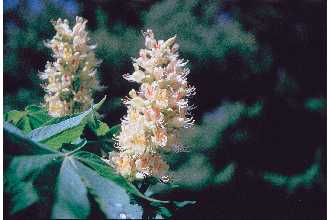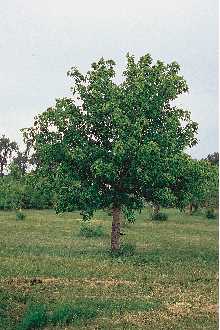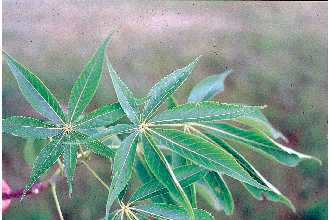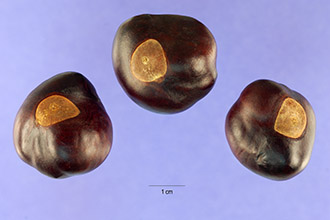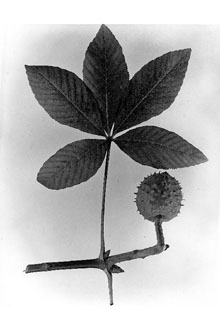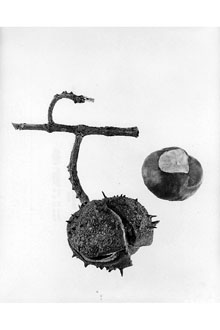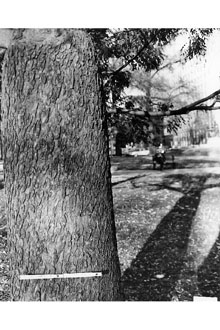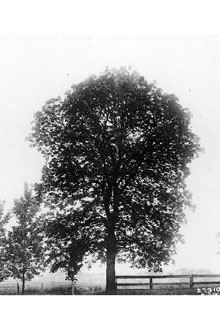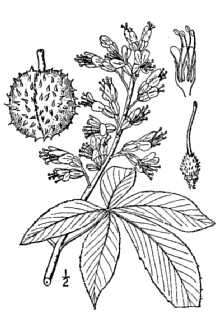Ohio Buckeye
Scientific Name: Aesculus glabra Willd.
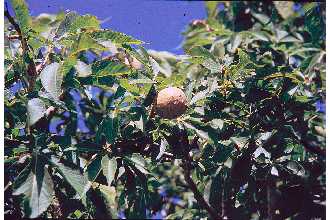
| General Information | |
|---|---|
| Usda Symbol | AEGL |
| Group | Dicot |
| Life Cycle | Perennial |
| Growth Habits | Tree |
| Native Locations | AEGL |
Plant Guide
Uses
Poisonous Plant: All parts of the plant (leaves, bark, fruit) are highly toxic if ingested – because of the glycoside aesculin, the saponin aescin, and possibly alkaloids. Symptoms are muscle weakness and paralysis, dilated pupils, vomiting, diarrhea, depression, paralysis, and stupor. Many landowners have eradicated it to prevent livestock poisoning. Native Americans ground buckeye to use as a powder on ponds to stun fish. Commercial: The soft, lightwood of Ohio buckeye has limited commercial use as sawtimber and it is of little commercial importance. It is used for making artificial limbs because it is light, easily worked, and resists splitting; it is also used in small quantities for various kinds of woodenware, crates, veneer, and toys. Pioneers used the wood for cabin structure and furniture. Nobel Foundation Plant Image Gallery © Samuel Roberts Noble Foundation Ornamental: The tree is an attractive ornamental, best in open, natural settings or parks because of its broad crown. It also is sometimes cultivated as an ornamental shrub. Other: Buckeye seeds have sometimes been carried as good-luck charms and to prevent rheumatism. Despite the poisonous properties to humans and livestock (below), squirrels are known to eat the raw seeds. Native Americans ate roasted seeds as a starchy meal.
Status
Please consult the PLANTS Web site and your State Department of Natural Resources for this plant’s current status, such as, state noxious status and wetland indicator values.
Description
General: Horsechestnut Family (Hippocastanaceae), Native, small trees, most less than 15 m tall (rarely to 45 m), with a dense oval to round crown, branching quite low, sometimes (usually on drier sites) a thicket-forming shrub; twigs thick, red-brown, hairy when young, with large triangular leaf scars; terminal buds large, orangish brown with keeled scales; bark smooth and light gray, becoming rough and scaly, Leaves are deciduous, opposite, palmately compound, leaflets 5-7(-11), oval to obovate or lanceolate, 6-13 cm long with a finely toothed margin, emerging bright green, deepening to dark green, often developing yellow or orange fall color, emitting a strong fetid odor when crushed, The leaves have a somewhat unique shape, Flowers are creamy to greenish yellow, about 1-2 cm long, in large, showy, upright, branched, terminal clusters at ends of leafy branches, only those flowers near the base of the branches of a cluster are perfect and fertile -- the others are staminate; petals 4; stamens longer than petals, Fruits are rounded capsules about 3 cm wide, borne on a stout stalk, with a warty or prickly, thick, leathery husk; seeds 1(-3) smooth, glossy, chestnut-brown seeds, each with a pale scar (the “buck's eye”), Use soil moisture sensors to measure the soil moisture of Ohio Buckeye., The common name refers to its abundance in Ohio and the supposed likeness of the nut to the eye of a buck; other names are derived from the fetid odor of the crushed leaves, bark, broken twigs, and flowers, Variation within the species: Two morphological segments are said to exist within the species: var, glabra is the northern (northwestern) segment with 5 leaflets, var, arguta the more southern form with 7-11 leaflets and other minor and variable differences in vestiture and leaflet shape, Var, arguta is weakly differentiated and commonly not recognized (see for example Diggs et al, 1999),
Distribution
Primarily a species of the east-central US. Var. glabra grows from western Pennsylvania, Ohio, and southern Michigan west to Illinois and south to Tennessee, Alabama, and rarely in Georgia, Mississippi, and states peripheral to the main northern range. Var. arguta (if recognized) is native to upland forests of Texas, Oklahoma, Arkansas, Missouri, Kansas, Missouri, Iowa, and Nebraska. Ohio buckeye is planted in various localities in the eastern US, including localities north and east of its main range. For current distribution, please consult the Plant Profile page for this species on the PLANTS Web site.
Adaptation
Ohio buckeye occurs in mixed hardwood forests of bottom lands along river and stream banks and in rich, moist soils of ravines and other steep to gentle slopes, less commonly on drier sites mixed in oak-hickory stands, on limestone slopes in the southwestern portion of the range. It is shade tolerant and often found in beech-sugar maple woods. In dense stands, side competition and shade foster straight boles and encourage natural pruning of this tree, which otherwise tends to have a large crown that retains branches on the lower portions. Ohio buckeye is one of the first trees to leaf out in spring. Flowering: March-May, after the leaves appear; fruiting: September-October.
Establishment
Seeds of Ohio buckeye ordinarily germinate in the spring after wintering on the ground. Seedlings can grow under some shade, but the species seems to develop best as isolated individuals in openings along streambanks and on other moist sites. Young trees show moderate growth rates and may begin producing fruit at 8 years. Most trees live 80-100 years. Ohio buckeye can be propagated by seed (stratify 60-120 days at 33-41° F); seeds must be kept moist to avoid loss of viability.
Management
Leaf scorch and leaf blotch are usually the most serious problems of Ohio buckeye. Leaf scorch, seemingly a response to heat and drought along urban streets, results in browning of the leaf margins. By late summer to early fall the trees look unsightly and are often partially defoliated. Air pollution may be more responsible for this problem than heat or drought. The leaf blotch (Guignardia aesculi) begins as brown spots or blotches on the leaves and may eventually give the tree a scorched appearance. This disease may slow the growth rate but does no permanent damage to the tree and can be controlled on ornamentals. Cultivars, Improved and Selected Materials (and area of origin) This tree is available through most local nurseries. Aesculus `Autumn Splendor' is similar to wild forms but has glossy dark green leaves that remain in good condition throughout the growing season, resistant to leaf scorch, and develops a maroon-red fall color. The Eurasian native horse-chestnut (Aesculus hippocastanum) is occasionally planted as an ornamental shade tree, but Ohio buckeye is more common. Ohio buckeye is often used as an understock for grafting cultivars of other species of Aesculus.
References
Brizicky, G.K. 1963. The genera of Sapindales in the southeastern United States. J. Arnold Arb. 44:462-501. Diggs, G.M., Jr., B.L. Lipscomb, & R.J. O’Kennon 1999. Shinners & Mahler’s illustrated flora of north central Texas. Sida, Botanical Miscellany, No. 16. Felter, H.W. & J.U. Lloyd 2000. King's American dispensatory: Aesculus. Scanned version. <http://metalab.unc.edu/herbmed/eclectic/kings/aesculus.html> Hardin, J.W. 1957. A revision of the American Hippocastanaceae. Brittonia 9:145-171, 173-195. Samuel Roberts Nobel Foundation 1999. Noble foundation plant image gallery. Ardmore, Oklahoma. 29nov2000. <http://www.noble.org/imagegallery/index.html> Williams, R.D. 1990. Aesculus glabra Willd. – Ohio Buckeye. Pp. 92-95, IN: R.M. Burns and B.H. Honkala (tech. coords.). Silvics of North America. Volume 2. Hardwoods. USDA, Forest Service Agric. Handbook 654, Washington, D.C. <http://willow.ncfes.umn.edu/silvics_manual/Table_of_contents.htm>
Plant Traits
Growth Requirements
| Temperature, Minimum (°F) | -33 |
|---|---|
| Adapted to Coarse Textured Soils | No |
| Adapted to Fine Textured Soils | Yes |
| Adapted to Medium Textured Soils | Yes |
| Anaerobic Tolerance | None |
| CaCO3 Tolerance | Medium |
| Cold Stratification Required | Yes |
| Drought Tolerance | Medium |
| Fertility Requirement | Medium |
| Fire Tolerance | Low |
| Frost Free Days, Minimum | 145 |
| Hedge Tolerance | None |
| Moisture Use | Medium |
| pH, Maximum | 7.1 |
| pH, Minimum | 5.0 |
| Planting Density per Acre, Maxim | 700 |
| Planting Density per Acre, Minim | 300 |
| Precipitation, Maximum | 60 |
| Precipitation, Minimum | 30 |
| Root Depth, Minimum (inches) | 36 |
| Salinity Tolerance | None |
| Shade Tolerance | Tolerant |
Morphology/Physiology
| Bloat | None |
|---|---|
| Toxicity | Severe |
| Resprout Ability | Yes |
| Shape and Orientation | Erect |
| Active Growth Period | Spring and Summer |
| C:N Ratio | High |
| Coppice Potential | No |
| Fall Conspicuous | Yes |
| Fire Resistant | No |
| Flower Color | Green |
| Flower Conspicuous | Yes |
| Foliage Color | Green |
| Foliage Porosity Summer | Dense |
| Foliage Porosity Winter | Porous |
| Foliage Texture | Coarse |
| Fruit/Seed Conspicuous | Yes |
| Nitrogen Fixation | None |
| Low Growing Grass | No |
| Lifespan | Short |
| Leaf Retention | No |
| Known Allelopath | No |
| Height, Mature (feet) | 68.0 |
| Height at 20 Years, Maximum (fee | 25 |
| Growth Rate | Rapid |
| Growth Form | Single Stem |
| Fruit/Seed Color | Brown |
Reproduction
| Vegetative Spread Rate | None |
|---|---|
| Small Grain | No |
| Seedling Vigor | High |
| Seed Spread Rate | Slow |
| Fruit/Seed Period End | Fall |
| Seed per Pound | 58 |
| Propagated by Tubers | No |
| Propagated by Sprigs | No |
| Propagated by Sod | No |
| Propagated by Seed | Yes |
| Propagated by Corm | No |
| Propagated by Container | Yes |
| Propagated by Bulb | No |
| Propagated by Bare Root | Yes |
| Fruit/Seed Persistence | No |
| Fruit/Seed Period Begin | Spring |
| Fruit/Seed Abundance | Medium |
| Commercial Availability | Routinely Available |
| Bloom Period | Mid Spring |
| Propagated by Cuttings | No |
Suitability/Use
| Veneer Product | No |
|---|---|
| Pulpwood Product | Yes |
| Post Product | No |
| Palatable Human | No |
| Palatable Graze Animal | Low |
| Palatable Browse Animal | Low |
| Nursery Stock Product | Yes |
| Naval Store Product | No |
| Lumber Product | Yes |
| Fuelwood Product | Medium |
| Fodder Product | No |
| Christmas Tree Product | No |
| Berry/Nut/Seed Product | No |

